Chanterelles: Sustainable and Considerate Harvesting
In the same way as we might apply different harvesting strategies to different edible plants, seaweeds or fruits, so different edible fungi require species-specific insight and understanding in order to come up with appropriate harvesting strategies. Catch-all rules might be simple and easy to remember, but the truth is that the world – and especially fungi – are not homogenous, but infinitely complex and nuanced. Even within a single species, there can be a great deal of variation, and a considerate forager will develop suitably nuanced context-sensitive harvesting strategies.
This post takes a deep dive into the science and ethics relating to the harvesting of chanterelle mushrooms. If you aren’t already familiar with chanterelles, I recommend reading this post first:
For a more general insight into the science and lifecycles of fungi, and to understand some of the terminology, it might help to read this post too:
For further discussion of the legalities, ethics and politics of foraging more generally see here:
- Responsible Foraging
- Legal Foraging
- How to Harvest Wild Mushrooms: Cutting v Picking
- Foraging, Sustainability and the Media
- Foraging In The Modern World: Eating Nature
Chanterelles were the thing that first got me hooked on foraging over 30 years ago, and i’ve been building my relationship with them every year since. The more you see, the more you see there is to see! There is always more to learn. But below is some of the insight i’ve gained through both practical experience and research down the years.
Note: While this post refers to chanterelles (cantharellus cibarius) in the UK, much of it can also apply to other slow-growing, insect resistant fungi, notably winter chanterelles and hedgehog mushrooms. Other subspecies of chanterelle also exhibit similar characteristics to those discussed below.
Distribution and Abundance of Chanterelles
What may seem like a rare and precious mushroom in one area may be hyper abundant in another, and this is well illustrated by chanterelles.
There are sitka spruce plantations in Scotland where chanterelles form a golden carpet for mile upon mile between July and October every year, and one might harvest them from dawn until dusk and still not be able to tell where you have been gathering. The vast majority of these grow, mature and rot by the ton every year, like blackberries do in our hedgerows.
Similarly I know large areas of birch woodland where chanterelles grow large and form big patches for mile upon mile. Such abundance can be a very useful food source, and for those seeking to reduce food miles by eating locally it seems extremely wasteful not to take advantage.
I feel that foraging works best when done on an intimate, personal level to feed ones self, friends and family, but it seems extremely wasteful and churlish to ignore chanterelles as a commercial resource, saving food miles and allowing people to eat locally and well in areas where they appear in such abundance. You can read more about commercial fungi harvesting here.
In other areas chanterelles may appear only in a few precious clusters – half a dozen here, a basketful there – enough for one family to gather sufficient for a cherished meal once or twice a year.
So clearly some consideration of the context is important, whether you are harvesting yourself, or advising someone else how they should, or shouldn’t, harvest them. It is understandable that someone who lives where chanterelles feel like a rare and precious commodity gets a bit het up when they see someone sharing photos of brimming baskets, or hears of chanterelles being traded commercially.
The best way to understand appropriate harvesting strategies for chanterelles is to revisit their locations year after year, and gain a feel for how and when they do well, and what feels like an appropriate harvest for their context, given the large array of variables that influence their abundance.
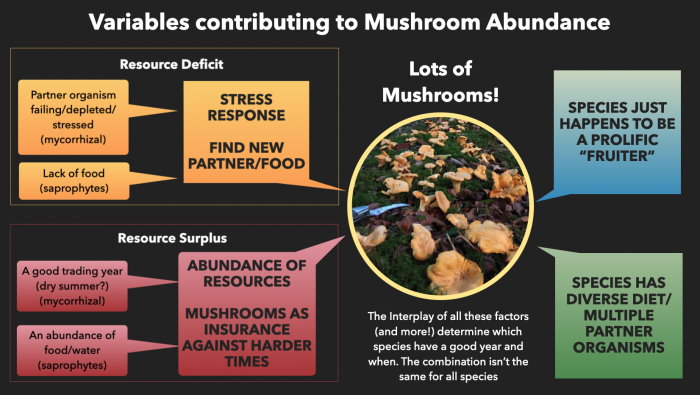
Some factors influencing the abundance of mushrooms in any given place at any given time – note that not all of these factors relate specifically to chanterelle abundance. For a full exploration of this see my fungi webinars, especially: Understanding Fungi and 20 Common, Poisonous, Delicious and Deadly Mushrooms to learn before you die, in which factors influencing mushroom abundance are explored in detail. Infographic ©GallowayWildFoods.com.
Chanterelles: Rate Of Growth and Spore Production
Unlike most other mushrooms, which grow rapidly and produce large flushes of spores over a week or two, chanterelles grow relatively slowly (2–5 cm per month), persist for an average of 44 days, and produce a continuous supply of slowly maturing spores over a month or two (Largent, 1994; Largent & Sime 1995). My experience in the warm, wet summers of West Scotland (optimum growing conditions for chanterelles) suggests that they can grow a good bit faster than that, and persist on the woodland floor for even longer.
This slow growth (by mushroom standards) and slow release of spores means that, apart from disturbing their mycelium, the worst way you can behave when harvesting chanterelles is to take the immature buttons. As we will see below, the science is clear that while this does not affect mushroom production at that location in future years, it does mean that the patch is less likely to reach and colonise new locations. Even from a purely selfish point of view, picking tiny buttons is an own-goal, removing the potential for a bigger harvest a month down the line.
In general, a minimum cap diameter of 2cm seems like a sensible starting point.
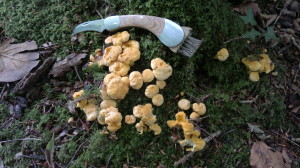
When they first emerge, chanterelles are just tiny buttons. Harvesting them at this stage means you get a fraction of what you might have had if you’d come back a month later, and undermine their reproductive potential. ©GallowayWildFoods.com
It is unfortunate that button chanterelles tend to be more sought after by chefs due to their firmer texture and because they look good in sauces, and commercial mushroom buyers offer a premium rate for “buttons”. Having said that, for reasons we will explore below, chanterelles sometimes don’t grow much bigger than 2cm. And, where there are literally thousands of chanterelles, there’s no great harm in taking a selection of sizes to use in different ways.
The only way to get a feel for what is a reasonable harvesting strategy for any given location is to start with restraint, then work at developing an intimacy and understanding of the that location over multiple seasons.
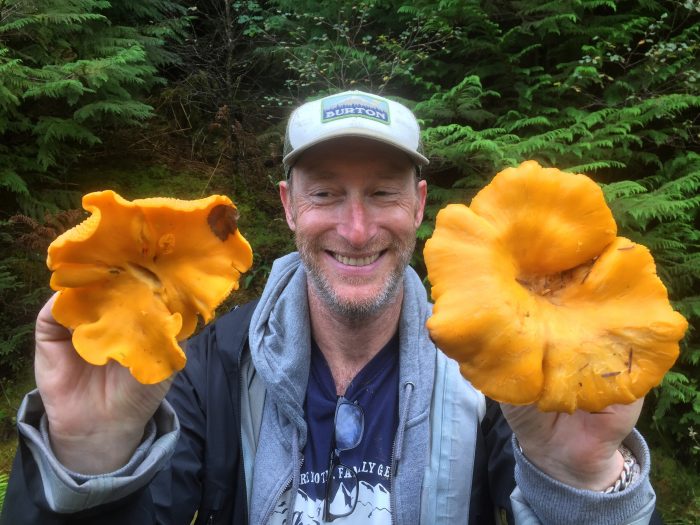
In a good growing year, in optimum conditions, its not unusual to find chanterelles as big as your head, as modelled here by my friend John Rensten of Forage London who joins me for a bit of highland fungi tourism from time to time. ©GallowayWildFoods.com
The slow spore release reproductive strategy of chanterelles explains why they have evolved chemical resistance to insects – see here for a fascinating further insight into this.
“Less than 1% of golden chanterelles were infested with larvae, compared to 40% – 80% in other fungal taxa” (Hackman & Meinander 1979)
The resistance of chanterelles to fungal gnats and other insects means that, no matter what size of chanterelle you are picking, you can feel pretty good that you are not depriving insects of home or food. Along with their general lack of perishability, this contributes hugely to their popularity as a food harvest and their commercial viability.
These “attack-resistant” properties of chanterelles go even further, with research by Nick Iadanza revealing “high insecticidal activities, with similar potencies as some standard pesticides, as well as significant activities against bacteria, yeast, and moulds”.
The same research also sheds light on why chanterelles are less likely to be grazed by slugs and rodents than other fungi: “amounts of ergocalciferol, or vitamin D2 (a rare form of vitamin D in nature), which regulates calcium transport in humans has also been isolated from chanterelles. Vitamin D2 is used in rodenticides because it causes accumulation of calcium (hypercalcemia) in mammals. However, it would be difficult to consume enough chanterelles to reach toxic vitamin D2 levels in humans. Also, in response to bruising or injury, chanterelle fruit bodies form hydroxylated fatty acids, such as as cibaric acid, and (8E)-10-hydroxydec-8-enoic acid. These fatty acids are heat labile, and destroyed during cooking. It is thought that the high amounts of vitamin D2 and these fatty acid derivatives may explain why insects, slugs, and other organisms rarely attack chanterelles”.
Of course, the occasional hungry slug will graze on chanterelles, but with nowhere the voracity with which they devour other fungi – notably boletes and amanitas. Hedgehog mushrooms and winter chanterelles seem to be even less appealing to slugs than chanterelles.
Scientific studies have found individual chanterelles to be firm and viable for eating as much as 113 days after first appearing (Largent & Sime 1995), and my own experience in Scotland concurs with this. They pick clean, stay firm, and keep in the fridge for a couple of weeks, provided they have a decent flow of air around them.
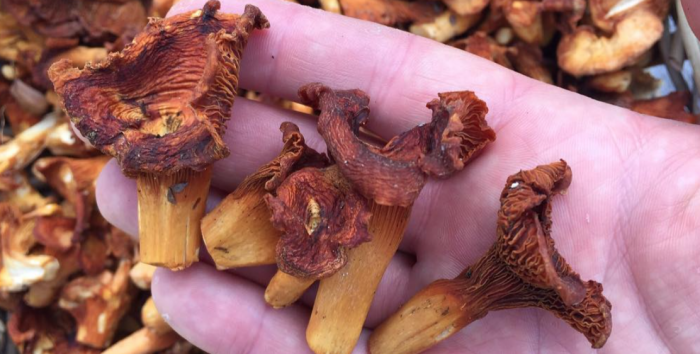
Chanterelles harvested during a long hot period. Not prime specimens by any means, but still fine for taking home to complete the drying process. ©GallowayWildFoods.com
The main enemy of the chanterelle forager is a hot dry period during their growing season. Where this occurs they tend not to grow to their full potential, and go tough and dry. Once this has occurred, they are unlikely to rehydrate and start growing again if the weather breaks. It is still possible to harvest them in their naturally dried state, and finish the drying process at home. In my opinion dried chanterelles are not the finest fungal larder item, but still well worth having.
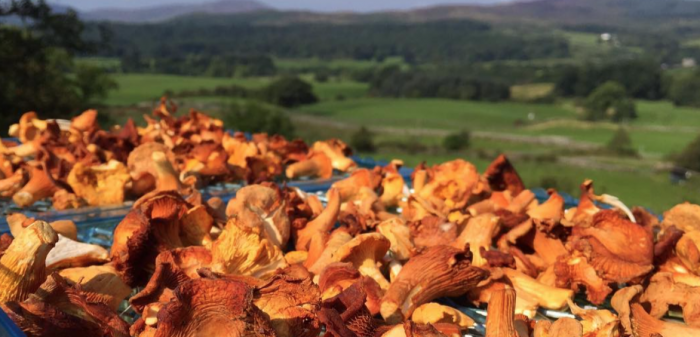
Sun-drying chanterelles “rescued” from a heat wave. Mushrooms absorb vitamin D if dried gills-up in sunlight, but its best to finish the drying process in a dehydrator or very low oven. ©GallowayWildFoods.com
Later on in the season, things can get too wet, and chanterelles tend to get waterlogged, slimy and less appealing for the kitchen. I say “less appealing”, but in my opinion even old wet flabby November chanterelles can still be a delight once cooked, or can be dehydrated and ground to a useful powder. More chanterelle cooking tips here.
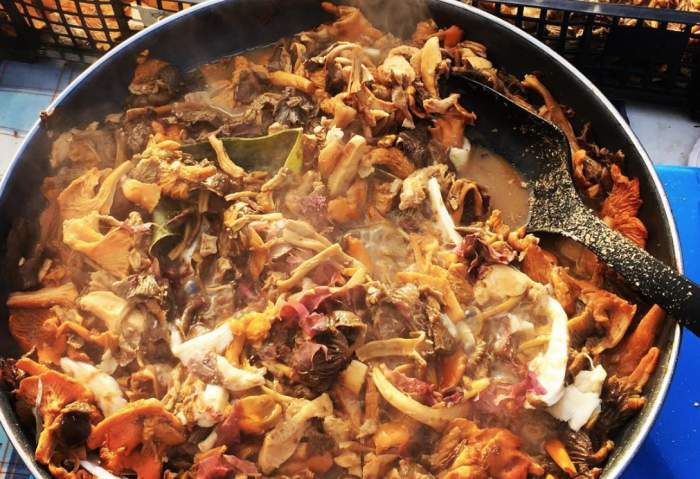
Cooking soggy late-season chanterelles (and other fungi). The juice exuded can be collected and reduced to a rich mushroom stock. ©GallowayWildFoods.com
What is a “good year” for chanterelles?
Chanterelles do especially well in mild, damp summers. This means they thrive in West Scotland, where they seldom have a “bad year” – though some years are certainly even more prolific than others. They usually start to appear around mid June in Scotland.
A hot dry summer, with only the odd wet day, means they will stutter, fail to reach their full size and be less abundant than in damper summers. In such years I focus more on my riverside patches and less on those in more open woods.
In the South of England, and much central and southern Europe, they can be less of a “summer mushroom” and may not get going until early or mid-autumn.
As one of the most easily recognised and sought-after wild mushrooms, I take reports of “bad chanterelle years” with a pinch of salt. Often, when I enquire more closely, the person reporting this has just one or two sites in accessible locations, and it seems much more likely that someone has beaten them to the harvest, than that there weren’t any at all. To really develop a clear understanding of “good”, “bad” or “indifferent” chanterelle years (or for most other fungi for that matter), its necessary to have at least 7 year’s intimacy with a range of different locations.
Given their love of damp, warm summers, it seems likely that chanterelles will be one of the “winners” as climate change increasingly impacts the UK.
When is a chanterelle fully grown?
Like fruits, the maximum size of most mushrooms can vary greatly within a species, and chanterelles are no exception. There are several variables:
- Genetic characteristics within the species – ie. some mycelia just produce bigger or smaller than average mushrooms, in the same way as some humans produce bigger or smaller than average children.
- Varied phenotypes – resulting from the interaction of its genetic characteristics with the environment, in the same way that a large child may not grow to be a large adult if they are malnourished. In terms of chanterelles (and fungi in general), environmental variables might include:
- The species, health and age of it mycorrhizal (tree) partner. Things get complicated here. As chanterelle mycelia help trees with the uptake of water and nutrients, they may expend more of their resources on this, rather than reproduction (producing mushrooms), in a hot dry summer.
- Macro climatic conditions – ie. a wet summer
- Micro climatic conditions – ie. a stream side that never dries out
- Drainage
- Soil type – although chanterelles prefer acidic soils, the most prolific patch of them I have ever seen occurred where an acidic spring rose in an alkaline soil.
- Ground cover – grass, heather, bracken etc can help trap moisture and encourage bigger mushrooms
There are a lot of variables here, which is why it is hard to know just when a chanterelle is good to go. But in terms of allowing chanterelles a fair chance to release viable spores, their slow growth and correspondent slow spore release means not pouncing on the first buttons you see emerging. That isn’t rocket science!
Given their resistance to decay, there is really no excuse for harvesting young specimens compared to, say, ceps, which are often decomposing before they are even half way to maturity. (See my post on ceps for the different nuances of harvesting rapidly growing, rapidly spore-dropping, rapidly decomposing mushrooms).
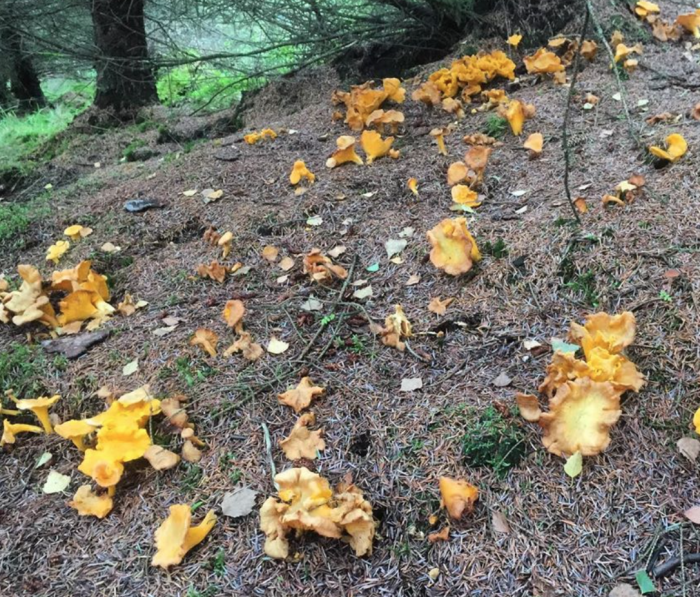
All these chanterelles have stopped growing. Note the lack of ground cover/moss. ©GallowayWildFoods.com
The Impact of Harvesting Chanterelles: Scientific Evidence
Before we tie ourselves in knots over this, its worth checking the science.
We are fortunate that chanterelles are one of few edible wild mushroom species on which we have a good selection of scientific research into the influence of harvesting them on future growth.
The following extract is from a 25 year scientific study:
” In 1975, we started a field research project to investigate the effects of mushroom picking on fruit body occurrence. […] The results reveal that, contrary to expectations, long-term and systematic harvesting reduces neither the future yields of fruit bodies nor the species richness of wild forest fungi […] Forest floor trampling does, however, reduce fruit body numbers, but our data show no evidence that trampling damaged the soil mycelia in the studied time period.”
Another study concludes: :
” (i) no statistically significant correlation between sporocarp removal and productivity, (ii) an outcome not influenced by harvesting method (pulling versus cutting); (iii) a significantly positive correlation between chanterelle abundance and average summer temperature; and (iv) no correlation between chanterelle abundance and precipitation.”
And further notes that:
“Because chanterelles have such a long fruiting season and lifespan it is probable that chanterelle remain in the field to sporulate in even rigorously hunted habitats. If our systematic chanterelle removal for 5 months a year at the same site for 10 years does not significantly decrease our chanterelle productivity, careful harvesters (who try to avoid habitat destruction) will probably not threaten future “crops”
– From Norvel – “Loving the Chanterelle to Death: The Ten Year Oregon Chanterelle Project”. This research seems to regularly disappear behind an academic paywall, but you can read its findings (and lots more interesting research on chanterelles) by going to Section 46. Recent Research in this document: “Ecology and Management of Commercially Harvested Chanterelle Mushrooms”.
I’d say that is pretty conclusive in relation to your impact on the fungi itself:
- Don’t pick tiny ones
- Pick larger ones freely
- Consider the mycelium: watch your feet and tread lightly!
Does All Chanterelle Mycelia Produce Chanterelles?
The more you look, the more you see there is to see. So lets go a bit deeper into the undergrowth…
Experienced chanterelle foragers may notice a tendency for chanterelles to proliferate along edges. This might mean a path edge, a river bank, or the edge of their suitable habitat, such as the boundary of a spruce plantation.
A plausible explanation for this, consistent with more general observations of fungi, is that their mycelia is likely to be present throughout the habitat, but only triggers its reproductive phase (ie. mushrooms) when it reaches the extent of that habitat.
If this seems surprising, it is worth remembering that mycorrhizal mycelia can grow ‘vegetatively’ (wrong word scientifically, but you get the picture!), from partner tree to partner tree, without ever producing a mushroom. This is also helps to explain why some of those places that seem like ideal chanterelle terrain often produce precious few chanterelles: the mycelia is just too happy to waste energy making mushrooms!
This ability of some fungi to spread by mycelial growth rather than by spores has historically been overlooked – understandable considering how tricky to observe they can be. Recent advances in DNA sequencing have revolutionised the way mycologists look a fungi. Mycelia have been found in Scotland that do not produce mushrooms with genetically viable spores, but match other colonies in central Europe. The conclusion? They could only have spread through mycelia running from tree to tree – way back when there was a land bridge and largely uninterrupted tree cover.
A mycologist friend of mine talks about mushroom production as an “insurance policy” on the part of the mycorrhizal fungi, rather than the be-all and end-all of their existence. Note that the same does not apply to many saprophytic fungi, which must rapidly jump from substrate to substrate as they expend finite food resources. There is a lot less pressure on, say, a chanterelle, that relies on a tree with a lifespan of 60 years (birch) to 300 years (oak) for its resources, than say a wrinkled fieldcap, that quickly devours piles of leaf and bark then must find more or perish.
What mycorrhizal and saprophytic fungi do have in common is that the production of mushrooms is often a stress reaction to environmental challenges to the health and/or spread of the mycelia. The most obvious challenge is winter, which is why a drop in temperature in autumn triggers high mushroom season.
I’ve seen this phenomenon in extremis on a small “island” of beech trees growing in the fork of a long, narrow V where two streams meet. Unable to jump to new partner trees through mycelial growth (but also enjoying the dampness of the setting), I find vast numbers of chanterelles in a tiny area. This also helps to explain the single densest flush of chanterelles I have ever seen, where an acid spring rose in alkaline soil. Where foot soldiers (mycelial growth) can go no further, the airborne (spore producing mushrooms) are mobilised!
So next time you are wandering through a forest wondering “where the hell are all the mushrooms?!”, consider that there may be – in fact there is very likely to be – an extremely happy mat of mycelium under your feet, and head for the edges of that comfort zone…
Considerate Chanterelle Harvesting: Who’s Patch Is This Anyway…?
So we now have a good insight into what fair and reasonable harvesting is in terms of the chanterelle mycelia itself, and the trees that they partner. And we have learned that not much else depends on chanterelles for food or habitat.
But to be a considerate forager we need to think of other humans too.
Because of their perennial nature, and especially where chanterelles are less abundant, foragers develop a sense of ownership, or hopefully stewardship, towards their locations. We quickly think of a patch as “ours”, and it can feel like a violation to find someone “trespassing” on “our patch”. I do this as much as the next forager, and wrote about it here.
I think it can help alleviate the worst inclinations of our possessive mindset if we consider, or even imagine, upon finding a chanterelle patch, that it may already be a cherished resource for someone else.
Admittedly, there are two ways this can go. Option 1 is to get competitive, and pick them earlier and smaller – beating your (real or imagined) “rival” to the resource. A bit like panic buying, this is a self-fulfilling, and ultimately harmful loop – for the fungi, anyone else who might appreciate it, and, ultimately, you.
You’ll enjoy the whole experience of finding, harvesting, eating and re-visiting the location in future seasons if you think “I’ll leave these for someone else to enjoy” as you gather. As you develop a relationship with the patch over time, you may come to know its other courtesans. Chances are they won’t be pleased to see you with a basket on “their” patch, but it is possible to “infect” them with your generous nature, and perhaps subtly let them know that you’ve been visiting for years, and leaving plenty for others to enjoy.
Its also worth remembering that not everyone is interested in foraging. Many nature lovers, who are yet to make the link between defending nature and eating what is abundant and local, still really appreciate the beauty of fungi.
I guess i’m fortunate in SW Scotland that, although we don’t quite have the golden carpets of NW Scotland’s plantations, there are plenty of locations. I guess I have 30 or so known spots, some of which produce a few handfuls, others where I can fill baskets several times a year. So if I find someone else is courting one of “my” chanterelle spots, I just go visit a different one, or better still, go find a new one. I also tend to leave spots that are easy to find for “casual foragers”. For me, the thrill of new discovery is usually even better than the warmth of familiarity. I wrote more about these two types of foraging here.
Incidentally, its remarkable how quickly people can develop a possessive attitude toward wild mushroom locations, and how quickly and conveniently they will forget who introduced them to a location in the first place! So while i’m fairly generous about sharing information about small patches, and locations where I teach, my favourite locations will probably go with me to the grave! I wrote about other reasons why I don’t share my favourite locations here.
Humans as Spore-Bearers
I sometimes wonder whether edible fungi like chanterelles have evolved to take advantage of humans. Certainly many plants have, in fact wheat, grass, barley and maize could be said to have mastered humans. I guess its less likely when it comes to mushrooms, as they are generally not so nourishing as plants.
But now we have developed a taste for them, I see no reason why we might not become extremely helpful toward the fungi we cherish in the kitchen. If they could express a preference, I expect most chanterelles would be very happy to picked at their spore-bearing stage and carried through the woods – gills down – in an open basket.
Thus considered foragers become a vector for the distribution of fungi spores, carrying them to new habitats to team up with new trees and reinforce the bond between humans and the earth.
Related Articles:
- Chanterelles – Edibility, Distribution, Identification, Ecology
- An Introduction to Fungi Foraging
- Responsible Foraging
- Legal Foraging
- How to Harvest Wild Mushrooms: Cutting v Picking
- Foraging, Sustainability and the Media
- Foraging In The Modern World: Eating Nature
- Hedgehog Mushrooms – Edibility, Distribution, Identification, Ecology
- Winter Chanterelles – Edibility, Distribution, Identification, Ecology
References:
- “Mushroom picking does not impair future harvests – results of a long-term study in Switzerland”, SimonEgli et al, 2006
- “Effects of mushroom harvest technique on subsequent American matsutake production” – Daniel L. Luoma et al, 2006
- Norvel – “Loving the Chanterelle to Death: The Ten Year Oregon Chanterelle Project”. This research is now behind an academic paywall, but you can read its findings (and lots more interesting research on chanterelles) by going to Section 46. Recent Research in this document: “Ecology and Management of Commercially Harvested Chanterelle Mushrooms”.
- Nick Iadanza’s research into the chemical properties of chanterelles is hard to track down, but well summarised here.
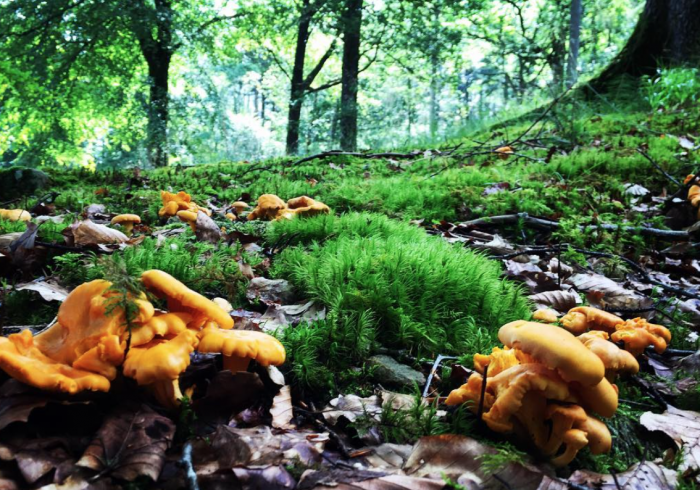
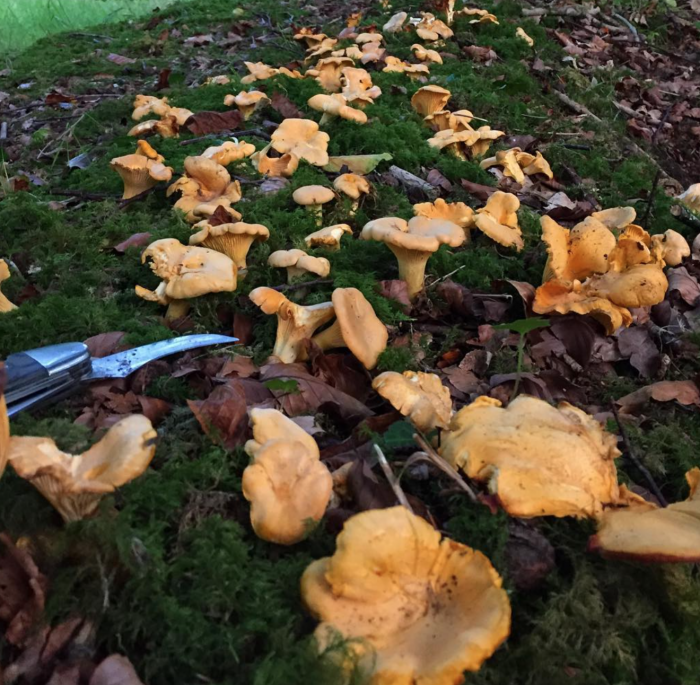
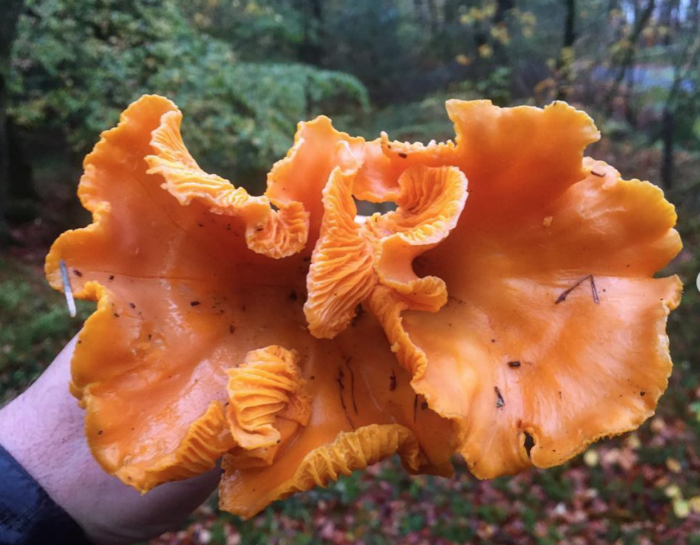
12 Comments
Fantastic article mark . Very in depth and full of lots of info to chew through !! I love the idea of finding the chanterelles where the two rivers meet . I once found a huge haul of hedgehogs which started (or most likely finished) next to a river and drew me deeper and deeper into the woods to a point that I could not continue through the thick undergrowth.
Always a pleasure to read your writings. Keep up the good work !!
Thanks for this great article! I’m a reader from Atlanta, GA.
WRT nutrition, according to the USDA website, chanterelle’s are 10% protein by weight, and one of the highest sources of vitamin C found in nature. Thanks for your great post!
Appreciate the great article that puts me at ease with “over”harvesting! Just returned from a productive chanterelle hunting trip here in the Oregon Coast Range. They only grow here in the wet winter (we have six months summer without a drop of rain) that arrived late this year, but make up for it by size! The biggest are generally the white chanterelles that appear solitary and I found a one-pounder today. Nothing like the patches in the article, but good spots might yield a gallon of yellow chanterelles.
Great read thanks Mark. I have noticed this edge effect a lot, especially when it meets a stream. That’s half the fun trying to ‘outwit’ the mushrooms, but as you say maybe they have outwitted us!
Went hunting for the first chanterelles of the year today. It’s been so dry they are small, rather dry and few & far between. No rain is sight for the next week either so I decided to experiment. ~ I found a couple patches and watered them. After watering, I covered them very loosely with leaves to disguise them from casual glances. I marked the spots and will return tomorrow to see what progress has been made over the night.
That sounds like great initiative and a really interesting experiment. What results did you find from your watering?
We lived in the Scottish Highlands for 15 years and I found that Chanterelles and other mushrooms too began to appear where they had not grown before, along the sides of my regular routes where I carried my basket with my harvest gills (and pores) facing down. I also disposed of waste parts where I would like more to grow, and they did, including Ceps. After a time I found I could tell when there was a favourite mushroom somewhere near, even if it wasn’t visible, and I would search the undergrowth and find it. But alas we moved away, and I miss my wild larder!
Fascinating. Thank you very much. We live on the Southern Oregon Coast and have a patch of what I (and a more experienced acquaintance) think are chanterelles. Will harvest some for her today.
Thanks for the interesting read, I have been lucky to have found a fairly large amount of golden chanterelle growing right in my own backyard, in South Georgia. Have about 6 acres mostly wooded with pine and oak. But the greatest number are appearing 10 yards from the back steps. Have buttons all over the place between some tree beds. Anybody know the best way to protect them from being stepped on/eaten by the many deer that constantly graze and visit, or other animals? Was thinking about getting some chicken wire and some stakes to help protect them. Not much foilage at that specific spot, so theyre right out in open and get splashed with dirt too when it rains (which is often). Found much larger beauties in the more wooded areas further away from the house.
Thanks!!
I just acquired a home on a large cattle ranch. Just yesterday I noticed a few dozen nice chanterelles growing under the live oaks in the yard around the house. There are water oaks and red oaks in the same area. The chanterelles are only growing under the canopy of the live oaks.
Picked 6 of the large ones and sautéed them with a tiny bit of butter, salt. pepper and garlic powder. Cooked on medium high heat in a nearly dry nonstick pan resulting in a really nice texture. I then added some sliced scallions and three scrambled eggs and a little cheddar. Rolled this into an omelet. Heavenly!
Greetings from Sweden, great article. I have been picking cantarell for a few years and have experienced many things in the article.But the article gave me more tips. thank you very much.